![]()
|
Special contributions to the previous, 1997, edition of "Globalization and Workers' Rights"
|
In this CD-ROM, globalization is defined as a process of growing interdependence between all people of this planet. People are linked together economically and socially by trade, investments and governance. These links are spurred by market liberalization and information, communication and transportation technologies.
A global economy is an unprecedented phenomenon, not to be confused with economic internationalization. In fact, a world economy has existed since the 16th century, based on the development of international trade, foreign direct investment and migration. The engine of the world economy is the national state.
A global economy has the capacity to work as a unit, in real time, on a planetary scale (see M. Castells, The Rise of the Network Society, Blackwell Publishers, 1996). Four primary, interrelated factors have driven globalization: increased international trade; the growth of multinational corporations; the internationalization of finance; and the application of new technologies in all these operations, especially computer and other information technologies (see D. MacShane, Fabian Pamphlet No. 575, 1996).
Definitions of globalization vary according to approach and according to sentiments the word awakes in the definer. In this CD-ROM, globalization and globalism are treated as expressions of the same phenomenon - globalization being the process and globalism the approach.
| Global developments Globalization in the form of foreign direct investment (FDI) accelerated in the middle of the 1980s. Total inflow of FDI was $643 billion in 1998, and total outflow was $648 billion. This is compared to inflows of $10 billion in 1970. (United Nations Conference on Trade and Development (UNCTAD) World Investment Report 1999) FDI consists of funds invested directly abroad from the headquarters of the transnational corporation, reinvested earnings of a foreign affiliate, and funds borrowed by an affiliate from its parent (UNCTAD definition). |
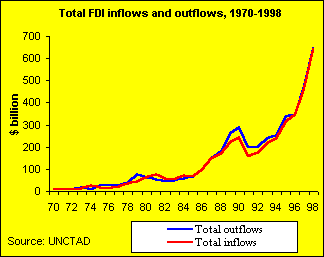 |
| The top investing countries in the 1990s have been the United States, the
United Kingdom, France, Germany and Japan.
In 1998, US investment rose by 22% over the previous year. Although, the investment of the United Kingdom (79%) and Germany (115%) rose much more, US direct investment abroad ($994 billion) was still almost twice as much as that of the United Kingdom ($499 billion), which had the second largest stock of FDI held abroad. |
 |
| FDI infows to United States nearly doubled to $193 billion
in1998. In the 1990s, China has received more FDI inflows than most developed
countries. Between 1993-1997, it was the second largest host country to
FDI. However, China received less in 1998 than in 1997. Although the US is the largest home and host country of FDI, and the growth of FDI outflows was marginal compared to inflows, outward FDI still exceed inward FDI. Whereas the outward stock was $994 billion, the inward stock was $875 billion in 1998. Japan, the United Kingdom, Germany and France are also net investors. Especially striking is the difference between outflows and inflows in Japan (see below). |
 |
Developed and developing regions Until recently, FDI flows have created interdependence between the developed countries, which are the main targets and sources of FDI. Developed countries are those with 1995 per capita incomes above $9,385 (World Bank definition). Although FDI flows into developed countries continue to exceed those into developing countries by far, the gap was narrowing until 1887. Inflows into developing countries in 1998 declined by 4%, to $166 billion. At the same time, inflows into developed countries gained by 68%, rising to $460 billion. However, in 1999 developing countries rebounded from their 1998 stagnation in terms of inward flows, according to UNCTAD preliminary results. (UNCTAD, World FDI grows 25 per cent in 1999, surpassing $800 billion) |
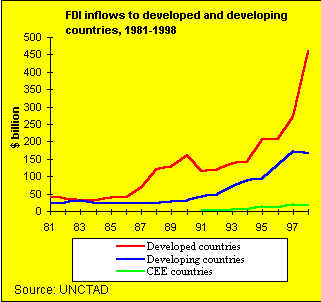 |
| In 1990s, outflows from developing countries have also increased.
In 1996, developing countries accounted for 15% of all FDI outflows. Since
then their share has sharply declined. In 1998, FDI outflows from
developing countries accounted for $52 billion, which was 8% of all FDI
outflows. FDI outflows from Asia declined from $52 billion in 1996 to $36 billion in 1998. Still, Asia accounted for 69% of the total developing countries' outflows. Most of the otflows originated in no more than 10 economies, primarily in East and South-East Asia. The stock of outward FDI from Asia reached $317 billion, accounting for over four-fifths of the total outward stock from developing countries. Over half of this stock is located in in other economies in the region, mainly in China. (UNCTAD, World Investment Report 1999.) |
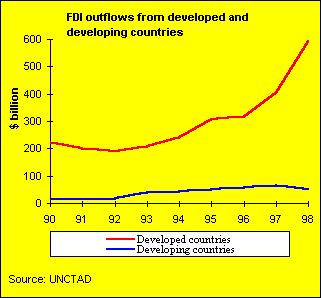 |
|
The EU and the United States have by far the world's most important bilateral investment relationship, and are each other's largest investment partners. In 1998, 63% (59 billion ECU) of extra-EU inflows came from the US. (Eurostat, Foreign Direct Investment 1998) Eurostat FDI figures include flows of equity capital and inter-company loans but exclude reinvested earnings. The main recipient of FDI from the United States was the United Kingdom. In 1998, the United States invested 27 billion ECU to the United Kingdom. |
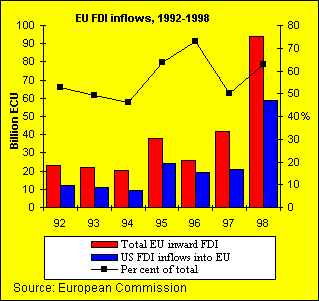 |
| The EU as a whole continued to be the world's most
important outward investor, and the United States market remained the main destination of FDI from the
EU. In 1998, the United States received 58% of EU outward
investments. Outflows from the EU to the
United States amounted to 112 billion ECU in 1998. (Eurostat,
Foreign Direct Investment 1998) Of the total outflows from EU countries in 1998, 127 billion ECU were invested to other EU member states, while 192 billion ECU were invested outside the EU. Inflows were 99 billion ECU from within the EU, and 94 billion ECU from the rest of the world. |
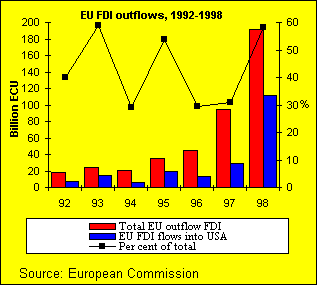 |
| The position of Europe in FDI outflows from the United States has traditionally been
strong. Half of the US outward stock ($490 billion) was in Europe, largely
in EU countries, in 1998. (US Bureau of
Economic Analysis (BEA), U.S. Direct Investment Abroad: Direct investment position
1994-1998, BEA, The International Investment Position of the United States at Yearend 1998)
US outflows to the Europe increased by 42% in 1998 (to $75 billion) and accounted for 61% of the total FDI outflows from the United States. Latin America and other countries of the Western Hemisphere received $18 billion, the Asia-Pacific region $13 billion, and Canada $10 billion. (US Bureau of Economic Analysis, US Direct Investment Abroad: Capital Outflows 1994-1999, BEA, The International Investment Position of the United States at Yearend 1998 ) See also: BEA, Direct Investment Positions for 1998: Industry and Country Detail |
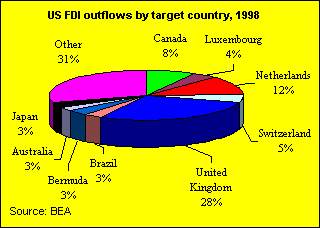 |
| 66% of the FDI stock in the USA in 1998 was from Europe ($540
billion), $151 billion from the United Kingdom. (US
Bureau of Economic Analysis, Foreign Direct Investment in the U.S.: Direct investment position
1994-1998)
The $189 billion increase in FDI hosted by the United States in 1998 was primarily sourced from parents located in Europe ($168 billion). Canada accounted for $11 billion and the Asia-Pacif region for $9 billion of the FDI inflows. (US Bureau of Economic Analysis, Foreign Direct Investment in the United States: Capital Inflows 1994-1999) |
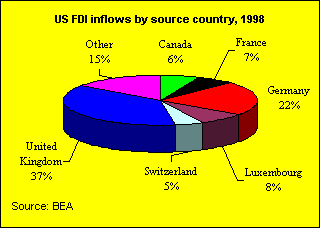 |
| Japan receives much less FDI than it makes. Outflows have exceeded
inflows by more than a factor of 10, and the gap has been growing until 1998.
While Japan's FDI outflows declined in 1998 (FY) by 21%, inflows almost
doubled. (Japan's Ministry of Finance, Foreign
Direct Investment Flows 1991-1999)
UNCTAD's figures deviate considerably from those of the Ministry of Finance, partly because the fiscal year begins in April, and ends in March of the next year. However, the dramatic change in Japan's FDI flows shows in UNCTAD's 1999 figures. According to UNCTAD's preliminary results, the inflows rose from $3 billion in 1998 to $14 billion in 1999. (UNCTAD, World FDI grows 25 per cent in 1999, surpassing $800 billion) |
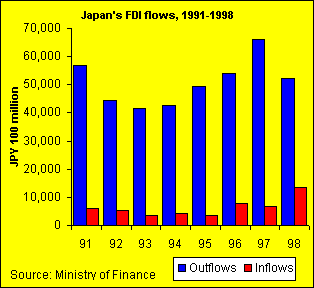 |
| It is interesting to note that FDI flows increased to
tax havents such as the Cayman Islands in 1998. The Cayman Islands became
actually the third largest recipient of Japanese FDI, after the United
States and the United Kingdom, accounting for 11% of the total outflows.
In 1997, it accounted for 5% of the total outflows. (Japan's
Ministry of Finance, Japan's Foreign Direct Investment Flows by Country & Region)
69.1% of the outflows went to non-manufacturing industries, finance and insurance being the biggest target industry. Finance and insurance accounted for 40,2% of the total outflows in 1998. (Japan's Ministry of Finance, Japan's Foreign Direct Investment Flows by Industry) |
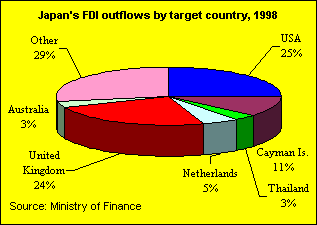 |
| Most of its FDI inflows Japan received from the United
States in 1998. As all inflows, investments from the United States
were concentrated in finance and insurance. Finance and insurance
accounted for 34.1% of all inflows in 1998. (Japan's
Ministry of Finance, Japan's Foreign Direct Investment Flows by Industry)
However, the inflows from the United States in finance and insurance declined cons iderably in the first half of 1999, by 83.5% over the first half of 1998. (Japan's Ministry of Finance, Japan's Foreign Direct Investment Flows by Industry & Region, 1st half of 1998 and 1st half of 1999)
|
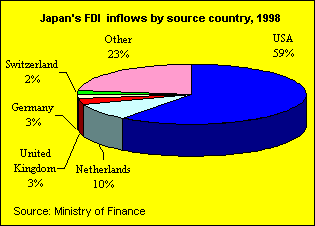 |
| Developing countries The share of FDI in total capital flows to developing countries doubled in the 1990s, from 28 per cent in 1991 to 56 per cent in 1998. For the first time in 13 years, FDI flows into developing countries declined in 1998, by four per cent to $166 billion. Among developing countries, FDI inflows concentrate in a few countries and regions. The main recipient regions are East Asia and the Pacific, and Latin America and the Caribbean (LAC). Of the total inflows of $85 billion to Asia and Pacific, $77 billion went to South, East and South-East Asia in 1998. China alone accounted for $45 billion. LAC received $71 billion in 1998. (UNCTAD, FDI Flows to Developing Asia Down and (UNCTAD, FDI Gains in Latin America) However, Latin America and the Caribbean replaced developing Asia as the largest host developing region in 1999, for the first time since 1986. According to preliminary estimates by UNCTAD, foreign direct investment flows to developing Asia in 1999 increased by 1 per cent over 1998 to US$91 billion. (UNCTAD, Foreign direct investment holds steady in developing Asia as a whole in 1999) FDI into Latin America and the Caribbean as a whole in 1999 increased by 32 per cent from to US$97 billion. (UNCTAD, Latin America and the Caribbean Attract Largest Share of Foreign Direct Investment in the Developing World in 1999) |
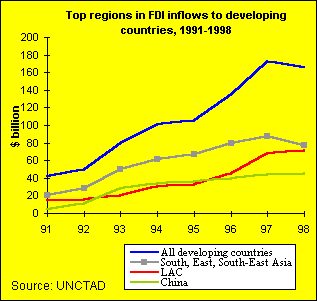 |
| Within East Asia and the Pacific, FDI inflows have concentrated in China, Malaysia, Indonesia, Thailand, Vietnam and the Philippines. China not only accounted for well over half of total FDI flows into the region, but was the third largest recipient in the world behind only the United States and the United Kingdom in 1998. While flows into China from other countries in the region fell, those from the United States gained 21 per cent. The Republic of Korea received its largest ever volume of FDI inflows at US$5.1 billion, a four-fold gain over its annual average in the first half of the 1990s, and $2.3 billion above the 1997 volume. The country became a net recipient after having been a net FDI outflow country since the start of the decade. (UNCTAD, FDI Flows to Developing Asia Down) | 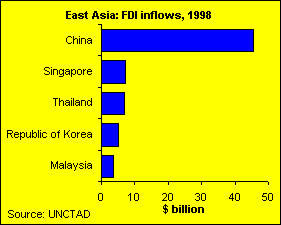 |
| Within LAC, South American countries attracted 70% of the
inflows, with the countries of the Southern Common Market (MERCOSUR)
receiving about half of the inflows in 1998. Brazil saw its inflows
increase by fully $10 billion to reach $28.7 billion, equivalent to 40% of
all inflows into the region as a whole in 1998. FDI inflows to both Mexico
and Argentina fell 20% and 30% respectively, which brought FDI into
these countries back to levels registered in 1995-1996. (UNCTAD,
FDI Gains in Latin America)
The notable
increase in 1999 was largely due to the quadrupling of FDI into Argentina
(from $6 billion in 1998 to $25 billion in 1999) and continued high FDI
flows into Brazil ($31 billion in 1999 compared to $28.5 billion in 1998).
|
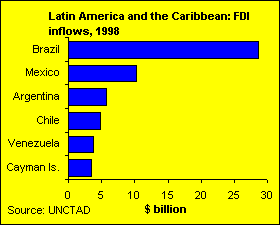 |
| Within the South Asia region, India and Pakistan have been the main recipients of FDI. Although the financial crisis did not significantly affect FDI in South Asia, the growth momentum of FDI into the sub-region was lost in 1998. (UNCTAD, World Investment Report 1999) |  |
| FDI flows into developing West Asia remained at a level
similar to that of 1997, $4.6
billion. Oil and oil-related activities are still attracting most FDI. (UNCTAD,
World Investment Report 1999)
FDI in Central Asia in 1998 also remained at a level similar to that of 1997 ($3 billion). The reduction of inflows in Kazakhstan was compensated for by increases in flows to Armenia and Georgia. The economies in the region are heavily dependent on investment in petroleum exploration and extraction, a sector that suffered from weakened international demand for oil. (UNCTAD, World Investment Report 1999)
|
 |
| Overall FDI inflows to the countries of Central and
Estern Europe were remarkably resilient in 1998, registering a minor
reduction of 4% compared with 1997, to about $19
billion. However this apparent stability masks two dramatically different
trends: on the one hand, the Russian Federation saw its FDI fall by more
than 60%, to a mere $2
billion in 1998; on the other hand the rest of the region as a whole
registered another record year, with FDI inflows topping $16 billion, i.e.
26% above in 1997.
FDI inflows remained concentrated in a few countries in 1998. Five countries, Poland, Czech Republic, Hungary, Romania and the Russian Federation accounted for 75% of the total FDI flows into the region. (UNCTAD, World Investment Report 1999) |
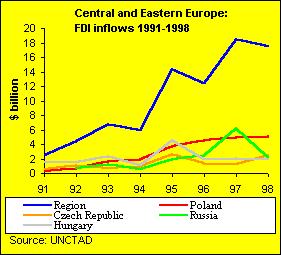 |
| Compared with other parts of the world, the overall volume of FDI to
Africa remains low, and thus a source of concern. Between 1991 and 1998, Africa attracted
some 5% of total FDI flows to developing countries.
Two countries were by far the most important FDI recipients in 1998: Egypt in North Africa and Nigeria in Sub-Saharan Africa. These two countries accounted for about one third of FDI inflows to Africa. FDI inflows into South Africa in 1998 fell far short of the record inflow figure attained in 1997. The main sources for FDI into Africa have traditionally been France, the United Kingdom and the United States and - to a lesser extent - Germany and Japan. While these countries remain important home countries for FDI flows to Africa , others such as Canada, Italy and Netherlands have gained in importance. Surveys conducted by UNCTAD indicate that both multinational companies and African investment promotion agencies consider that prospects for increased FDI flows into Africa have improved. (UNCTAD, World's largest transnational corporations cautiously optimistic about Africa's potential for attracting foreign direct investment and UNCTAD, Significant investment opportunities in Africa exist) |
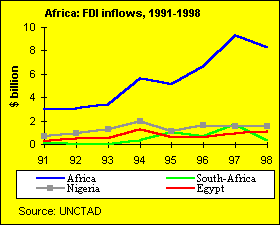 |
Related topics: Multinationals, Privatization
Portfolio holdings of equity and long-term debt securities reached nearly $5.2 trillion at the end of 1997.
The United States, United Kingdom, and Japan were the largest investing countries, accounting for almost 68% of such holdings, according to the IMF Coordinated Portfolio Investment Survey. The shares of the Netherlands, Italy, and France were each within 4% to 6% of the total. The Survey is the first major internationally coordinated statistical initiative designed to gauge portfolio claims on individual countries by the world's principal investing nations.
By definition, foreign direct investment and foreign portfolio investment are distinguished by the degree to which foreign investors exercise management control in a company. Portfolio investors tend to limit their involvement to financial engagements, while direct investors have a significant and long-lasting management interest in the company targeted for investment.
Although portfolio investments can make an important contribution to the financing of equity capital for local companies, concerns have been expressed by host countries particularly regarding the volatility of these flows and their effect on exchange and interest rates. (See F&D, Stock Markets - A Spur to Economic Growth, IMF, Foreign Exchange Markets - Structure and Systemic Risks (http://www.imf.org), F&D, Interest Rates - An Approach to Liberalization)
 Foreign securities held in
US portfolios increased $229.6 billion, to $1.9 trillion, in 1998. US holdings of foreign stocks increased $206.1 billion, to
$1.4 trillion. US holdings of foreign bonds increased $23.4 billion, to $561.8 billion.
(US Bureau of Economic Analysis,
The International Investment Position of the United States at Yearend 1998)
Foreign securities held in
US portfolios increased $229.6 billion, to $1.9 trillion, in 1998. US holdings of foreign stocks increased $206.1 billion, to
$1.4 trillion. US holdings of foreign bonds increased $23.4 billion, to $561.8 billion.
(US Bureau of Economic Analysis,
The International Investment Position of the United States at Yearend 1998)
In Japan, outward foreign portfolio investment outweighs outward foreign direct investment. Japanese portfolio investments abroad in 1998 amounted to 122,7 trillion yen, compared to outward FDI of 31 trillion. Inward portfolio investments amounted to 73.6 trillion yen in 1998. (Ministry of Finance, International Investment Position of Japan)
| Unlike FDI flows, foreign portfolio flows to
developing countries have been volatile. From a peak of $71 billion
in 1993, for example, they fell to $59 in 1995 in the aftermath of the
Mexican peso crisis, then almost doubled to $95 billion in 1996. During
1997 portofolio flows shrank to $62 billion. (United Nations, World
Economic and Social Survey 1999) Looking at allocations on a regional basis, East and South Asia received the most portfolio investment ($30 billion), followed by Latin America ($23 billion). Africa received only $5 billion. (United Nations, World Economic and Social Survey 1999) |
 |
Related topics: Investment Funds
Global developments
Over the period 1950-1973, the volume of world trade (in goods and services) increased at an annual rate of nearly 8%, while world GDP rose annually by 5% in volume. In the decade following the abandonment of the Bretton Woods fixed exchange rate regime and the first oil price shock, the rate of expansion of both world trade and world GDP slowed down substantially.
Since 1983, the pace of world trade has accelerated again, reaching an average annual rate of 6% in the period 1990-95. This well outpaces the expansion of world GDP, which has risen at an average of only 3.4% per year. However, the pace of world trade has been slower than the pace of FDI..
| World GDP and trade growth slowed in 1998 as
the Asian crisis deepened and its repercussions were felt increasingly
outside Asia. The volume of world merchandise exports grew by 3.5 per cent
in 1998 after an outstanding growth rate of 10.5 per cent in 1997. The
deceleration in global output growth was less pronounced than for
international trade in 1998, as world GDP rose by 2 per cent, or by 1
percentage point less than in 1997 (World Trade
Organization (WTO), World Trade Growth Slower In 1998 After Unusually Strong Growth In 1997)
The dollar value of world merchandise trade ($5.2 trillion) declined by 2 per cent in 1998, the strongest decrease since 1982. The export value of manufactured goods continued to rise slightly while that of agricultural products, metals and fuels declined. These divergent developments by product category in 1998 pushed the share of primary products below 20 per cent in current price terms for the first time in the post World War II period. Exports of commercial services ($1.3 trillion) recorded the first annual decline in dollar value since 1983. All the three major services categories (i.e., transport, travel and other commercial services) saw a decrease.
|
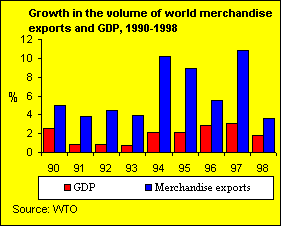 |
| Developed and developing countries In value terms, industrialised countries' exports increased slightly, by 0.4%, whereas developing countries' exports decreased by 6% in 1998. (Japan External Trade Organization (JETEO), White Paper on International Trade 1999) US exports decreased slightly (-0.9%) in 1998, as volume growth decelerated and prices declined. Japan's exports dropped by 7.8%. Exports of the European Union increased by 3.3%. Among developing
countries, exports decreased most in Africa, by 21%. According to the
UNCTAD, the world's 48 least developed countries, whose
population accounted for about 13 per cent of the world’s total population in
1997 - had a share in world exports of only 0.4% representing a decline of more than 40 per cent
since 1980.
(UNCTAD, Least Developed Countries Increasingly Marginalized in Globalized Economy)
In East-Asia, China's exports increased slightly and Philippines' exports by 10.7%, while exports of all other countries in East-Asia decreased. Also exports of the Latin America decreased.
|
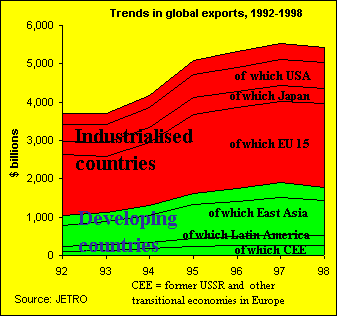 |
| In value terms, industrialised countries'
imports increased by 2.3%, whereas developing countries' imports decreased
by 15% in 1998. (Japan External Trade
Organization (JETRO), White Paper on International Trade 1999)
US imports increased by 5% in value terms, Japan's imports decreased by 17.2%. Imports of the European Union increased by 4.6%. Except for Africa, imports decreased in all developing countries. In East-Asia, imports decreased by 18.3%.
|
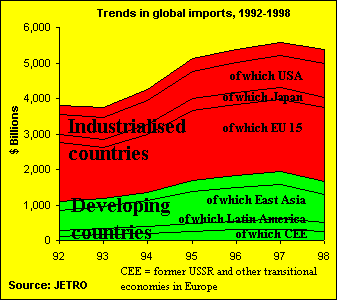 |
East Asian economies have a high intra-regional export ratio (35.2% in 1998), and the economic slump in the region was itself hindering the expansion of exports creating a negative chain reaction. In 1997-1998, intra-regional trade in East-Asia decreased by 15.2%.
China's exports to Japan fell by 6.7% and Japan's exports to China by 7.9% in 1997-1998. However, trade between these two countries in 1999 rose for the first time in two years to a record $66.18 billion dollars, up 16.3% from the year earlier. (JETRO, Sino-Japanese Trade Hits All-Time High)
Intra-regional trade in NAFTA increased by 5% and in EU by 5.1% in 1997-1998. In 1998, intra-regional trade accounted for 51.5% of NAFTA's exports and 62.7% of EU's exports.
See tables on the Growth of regional and world trade 1997-1998 and Shares of Exports 1998
Leading exporters and importers
The leading exporters and importers in world merchandise trade in 1998 were the United States ($683 billion), Germany ($539 billion) and Japan ($388 billion). However, if the European Union with its 15 member countries is considered a single entity (excluding intra-EU trade), it was a larger exporter ($813 billion) than the US. The leading exporters of world commercial services were the United States ($234 billion), the United Kingdom ($100 billion) and France ($79 billion), while the leading importers of world commercial services were the United States ($ 162 billion), Germany ($122 billion) and Japan ($110 billion). (World Trade Organization (WTO), World Trade Growth Slower In 1998 After Unusually Strong Growth In 1997)
The fastest-growing traders in 1990-1996, however, were developing countries. In exports, the highest annual average growth rates in 1990-1996 have been in Malaysia (18%), the Philippines (17%), China (16%) and Thailand (16%). In imports, the highest average growth rates have been in Argentina (34%), Poland (22%), Malaysia (18%) and the Philippines (18%). (WTO Secretariat, Report on Trade Developments 1997)
An indigenous element of global interdependence is global governance, although the word "governance" might be somewhat misleading in the global context. There is no global government or constitution. There are only regimes created by national governments for the regulation of global and international phenomena.
Traditionally, international affairs have been handled by arrangements between nation-states and their international institutions. The UN is the largest organization in history which is composed of nation-states, but it is not an institution of supranational governance. The UN Commission of Global Governance, in its report entitled Our Global Neighbourhood, concluded that although the governance of globalization also involves other actors, governments - and the UN as their forum - play the central role:
Internationally, governments have promoted the free flow of goods, services, money and work by concluding treaties and agreements on trade, investment liberalisation and global or regional economic integration. Arrangements including preferential tariffs, free trade associations, customs unions, common markets and economic unions (see definitions of these concepts) have multipled in recent years. Geographically, the most comprehensive of the recent arrangements is the World Trade Organization, WTO. The World Trade Organization was also considered as the likely forum for eventual negotiations on MAI (Multilateral Agreement on Investment), but in 1998 the negotiations which had begun in 1995 in OECD were ended. The decision not to continue the negotiations was preceded by a six-month period of assessment to reflect and consult with civil society, after it became clear in the OECD Council meeting at ministerial level in 28 April 1998 that the MAI negotiations were encountering significant difficulties, and after France annouced that it would no longer send its delegation to participate in the negotiations.
Regarding regional integration, three trends are visible:
The Latin American Free Trade Association (LAFTA) was replaced with the Latin American Integration Association (ALADI) in 1980.
System of Central American Integration (SICA), which was established in 1993 and is currently functioning as a customs union, developed from the Central American Common Market (CACM), which remains a free trade association.
Caribbean Community and Common Market (CARICOM) replaced Caribbean Free Trade Association (CARIFTA) in 1973.
Southern Cone Common Market (MERCOSUR) was established in 1991 to speed up the integration process of four ALADI members (Argentina, Brazil, Paraguay and Uruguay). Three other ALADI members (Mexico, Venezuela and Colombia) established a Group of Three in 1995. Venezuela and Colombia belong also to the Andean Community, which started operating on 1 August 1997.
Within each of these groupings, swift steps towards economic integration are being taken in order to prepare the member countries to join a Free Trade Area of the Americas (FTAA).
Asia-Pacific Economic Cooperation (APEC), formed in 1989, is currently implementing the Manila Action Plan for APEC (MAPA). MAPA revolves around six themes: greater market access in goods; enhanced market access in services; an open investment regime; reduced business costs; an open and efficient infrastructure sector, and strengthened economic and technical cooperation. APEC's goal is to advance Asia-Pacific economic dynamism and sense of community. Despite the financial instability of 1997-98, the Asia-Pacific remains one of the fastest growing regions in the world. It is a major contributor to global prosperity and stability. Today, APEC includes all the major economies of the region and the most dynamic, fastest growing economies in the world.
The Association of Southeast Asian Nations (ASEAN), established in 1967, started with a degree of cooperation, which was initially limited to only a few economic activities in the 1960s. Since 1992, ASEAN has implemented the ASEAN Free Trade Area, AFTA, involving abolition of internal tariffs and non-tariff barriers and establishment of a common external tariff. In addition to trade liberalisation, other measures are being implemented, such as trade facilitation, non-border measures, activities in investment and services promotion, and intellectual property protection. Bold decisions have also been made to elevate and strengthen ASEAN industrial cooperation through a new scheme, which will take into account the present industrial needs and economic situation within ASEAN. Cooperation in private-sector development, small- and medium-sized enterprises, infrastructure development and regional investment promotion have also made considerable progress.
Since 1991, the South Asian Association for Regional Cooperation (SAARC) , established in 1985, has implemented its Preferential Trading Arrangement (SAPTA) and has agreed on the removal of para-tariff, non-tariff and other trade control barriers within specific timeframes. Eventual progression to the creation of a free-trade area in the region has been agreed.
The Southern African Development Community (SADC), which replaced the Co-ordination Conference (SADCC) in 1992, has promised to create a southern African common market of 130 million persons. This economic community is dedicated to the ideals of free trade, free movement of people, a single currency, democracy, and respect for human rights. The Common Market of Eastern and Southern Africa (COMESA), which replaced the former Preferential Trade Area (PTA) in December 1994, has promised to remove all internal tariffs and trade barriers, and introduce a common external tariff structure to deal with all third-party trade, and will considerably simplify all trade procedures. Kenya, the United Republic of Tanzania and Uganda signed on 30 November 1999 the East African Co-operation (EAC) treaty, seeking to re-establish the defunct East African Community, which existed from 1967 to 1977, and create a common market in the region. The West African Economic and Monetary Union (UEMOA), was created on January 10, 1994. It is pursuing increased economic integration, which includes eliminating trade and non-tariff barriers on certain products, rationalizing and harmonizing the trade policies of the member countries vis-à-vis third countries, and gradually converging the economies of the member countries.
European Union (EU) is moving towards a monetary union with a single currency. On 1 January 1999, the EU single currency, the euro, was launched and the new European Central Bank (ECB) took over responsibility for monetary policy in the 11 countries making up the euro area.
In addition to economic aspects, most of these regional organizations also involve environmental and social aspects. These aspects are either incorporated into the treaties, charters or agreements establishing the individual organizations and associations, or they are included in side agreements or in the work of special institutions (working groups, technical groups, advisory bodies, etc.).
Mergers of regional organizations have taken place mainly in Europe and America.
The European Community (EC) and most members of the European Free Trade Area (EFTA) formed the European Economic Area (EEA) in 1994. In 1995, Austria, Sweden and Finland joined the EU. Similar developments are now taking place with the member states of the Central European Free Trade Area (CEFTA). Poland, Hungary, the Czech Republic, Estonia and Slovenia have been accepted by EU as new member candidates - except for Estonia, all are CEFTA members. Slovakia and Romania also belong to CEFTA, but are not among the current candidates for EU membership. All these countries have Europe Agreements with the EU. Negotiations got under way in 1998 with the first wave of six countries: Cyprus, the Czech Republic, Estonia, Hungary, Poland and Slovenia. These will be followed by a second wave of five countries: Bulgaria, Latvia, Lithuania, Romania and Slovakia. In September 1998 Malta reactivated its application and the Cardiff European Council launched the EU strategy to prepare Turkey for accession. In March 1999 the Berlin European Council reached agreement on the creation of new pre-accession financing instruments. (European Union, Enlargement)
In Latin America and the Caribbean, a number of mergers of organizations have already taken place, and more are expected. The draw of Mercosur in Latin America is growing stronger. The Andean Pact countries have been making swift moves towards provisional membership in Mercosur. But the biggest challenge is the Free Trade Area of the Americas (FTAA).
The FTAA would create the world's largest free-trade area, with 750 million people, and is scheduled to come into being latest by 2005. The FTAA would have 34 member countries: Antigua and Barbuda, Argentina, the Bahamas, Barbados, Belize, Bolivia, Brazil, Canada, Chile, Colombia, Costa Rica, Dominica, the Dominican Republic, Ecuador, El Salvador, Grenada, Guatemala, Guyana, Haiti, Honduras, Jamaica, Mexico, Nicaragua, Panama, Paraguay, Peru, St. Vincent and the Grenadines, St. Lucia, St. Kitts and Nevis, Suriname, Trinidad and Tobago, Uruguay, the United States of America, and Venezuela. The membership of the FTAA would be similar to the membership of the Association of Caribbean States (ACS), which was formed in 1995 by CARICOM together with Colombia, Costa Rica, Cuba, the Dominican Republic, El Salvador, Guatemala, Haiti, Honduras, Mexico, Nicaragua, Surinam and Venezuela.
The ambitious goal set by the leaders of the Western Hemisphere at the 1994 Summit of the Americas in Miami to create the FTAA has been given a significant push forward by the completion of the San Jose Declaration on March 19th, 1998. This Declaration, agreed by the Trade Ministers of the 34 participating democracies in the Free Trade Area of the Americas (FTAA) process, served as the basis for the launch of the Hemispheric trade negotiations by heads of state and government in Santiago, Chile on 18-19 April, 1998. These negotiations will encompass all of those areas previously negotiated and which fall within the World Trade Organization's ambit, with the goal of going beyond previously agreed multilateral liberalization within the Hemisphere, wherever possible. Importantly, however, the FTAA negotiations will include areas not presently under the WTO such as a common investment regime, government procurement, and competition policy, which are not yet subject to commonly-agreed disciplines among a large number of trading nations.
The number of member countries has increased in most associations. In 1994, Mexico joined the US-Canada Free Trade Agreement of 1988, and NAFTA was created. The original members of CARICOM were Barbados, Jamaica, Guyana and Trinidad and Tobago, and eight other Caribbean territories joined thereafter. The Bahamas became the 13th member of the Caribbean Community on 4 July 1983. Suriname became the 14th member on 4 July 1995. Haiti became a provisional member of Caricom on July 4, 1997. The current member countries and territories are: Antigua and Barbuda, Belize, Grenada, Montserrat, St. Vincent and the Grenadines, Turks and Caicos Islands, the Bahamas, the British Virgin Islands, Guyana, St. Kitts and Nevis, Suriname, Barbados, Dominica, Jamaica, Saint Lucia, Trinidad and Tobago and Haiti. In July 1991, the British Virgin Islands and the Turks and Caicos Islands became Associated Members of CARICOM. Twelve other states from Latin America and the Caribbean enjoy observer status in various institutions of the Community and in CARICOM Ministerial bodies.
The original members of the EEC were Belgium, France, West Germany, Italy, Luxembourg, and the Netherlands. Denmark, Ireland, and the United Kingdom joined in 1973, Greece in 1981, and Portugal and Spain in 1986; the former East Germany was admitted as part of reunified Germany in 1990. Greenland, a dependent state of Denmark that entered the EC when under full Danish rule, withdrew in 1985. Finland, Sweden and Austria joined in 1995.
The original member countries of ASEAN were Indonesia, Malaysia, the Philippines, Singapore and Thailand. Brunei Darussalam joined the Association on 8 January 1984. Vietnam became the seventh member of ASEAN on 28 July 1995. Laos and Myanmar were admitted into ASEAN on 23 July 1997. Cambodia joined ASEAN on 30 April 1999. APEC has also grown, to involve 18 countries (Australia, Chile, Indonesia, Malaysia, Papua New Guinea, Chinese Taipei, Brunei Darussalam, China, Japan, Mexico, the Philippines, Thailand, Canada, Hong Kong, Korea, New Zealand, Singapore and United States).
The SADC and COMESA have many common members (Angola, Namibia, Swaziland, Tanzania, Zambia and Zimbabwe). Egypt was admitted as a new member of COMESA in June 1998 with the aim of enlaraging and diversifying the regional market for member states.
Within each region, various cooperation agreements exist between organizations. There are also a number of regional cooperation organizations, such as the South Asian Association for Regional Cooperation (SAARC) and Latin American Economic System (SELA).
Cooperation agreements between organizations in different regions are also becoming more prevalent, and a new concept of "open regionalism" has emerged. Unlike the United States, the EU countries do not belong to any Asian grouping. In order to improve cooperation between Europe and Asia, therefore, an Asia-Europe Meeting (ASEM) was arranged in 1996. The Meeting agreed to develop a common vision of the future, foster political dialogue, reinforce economic cooperation and promote cooperation in other areas.
ASEAN has been very active in pursuing linkages with other regional trading arrangements. The AFTA-CER linkage was the first of these - its activities include creation of a customs compendium, information exchange on standards and conformance (including collaborative work on ISO 14000), and linkage of trade and investment databases. Similar initiatives are being pursued with other regional groupings such as the North American Free Trade Agreement (NAFTA), the Mercado Comun del Sur (MERCOSUR), the European Free Trade Association (EFTA), and the Southern African Development Community (SADC).
Cooperation between the European Union and the countries of Africa, the Caribbean and the Pacific dates back to the origins of the European Community. The Lomé Convention, which has been the framework for trade and development aid ties between the EU and 70 ACP states since 1975, is one of the most important facets of the European Union's external activities. This Convention expires on 29 February 2000, and negotiations between the contracting parties should start 18 months before that date, in September 1998. (see European Commission, Green Paper on Relations between the European Union and the ACP Countries on the Eve of the 21st Century)
In the globalization process, corporations are the actors who actually move their goods, services, money and work globally. Globalization began to boom in the aftermath of the oil crises in the 1970s, which:
All these developments were interrelated, and their effects were further strengthened through floating exchange rates. Before the first oil crisis in 1973, the most important stabilizing pillar of the postwar monetary system, the dollar-gold equivalence standard, had collapsed in 1971. Floating exchange rates vitalised speculation in currency markets and created insecurity within national economies and markets. When growth slowed and unemployment increased, protectionist tendencies also emerged.
This turmoil affected consumer behaviour as well. During the rapid growth of the 1950s and 1960s, mass production, mass sales and mass consumption became firmly established features. This allowed department stores, supermarkets, and speciality shops all to enjoy fast-expanding sales. But after growth slowed as a result of the oil crises, consumers became less interested in simply acquiring more possessions, and their desires began to show more diversity and individuality.
For companies, this new environment of continuous change meant restructuring, and in particular:
Technological advances made possible the efficient realisation and development of new business ideas. Information systems became a major tool for improving the cost-effectiveness of investments. They led to higher productivity, particularly in the industrial and service sectors - in the former through automation of manufacturing and related processes, in the latter through computer-aided decision making, problem solving, administration, and support for clerical functions.
Flexible production methods are realized through computer-integrated manufacturing (CIM). Computer-aided design (CAD) systems were first applied in the electronics industry. Today they feature three-dimensional modelling techniques for drafting and manipulating solid objects on the screen and for deriving specifications for programs to drive numerical-control machines. Once a product is designed, its production process can be outlined using computer-aided process planning (CAPP) systems that help to select sequences of operations and machining conditions. Models of the manufacturing system can be simulated by computers before they are built. The basic manufacturing functions - machining, forming, joining, assembly, and inspection - are supported by computer-aided manufacturing (CAM) systems and automated materials-handling systems. Inventory control systems seek to maintain an optimal stock of parts and materials by tracking inventory movement, forecasting requirements, and initiating procurement orders.
Teleprocessing transaction systems constitute the foundation of service industries such as banking, insurance, securities, transportation and libraries. They are replacing the trading floors of the world's major stock exchanges, linking the exchanges via on-line telecommunications into a global financial market.
Computer-based information systems have made possible the management of companies with units scattered around the world. The matrix organization, a structure in which departments and employees communicate directly with other organizational units, is an increasingly popular alternative to the traditional hierarchical structure. Information sharing and communication technologies are the principal factors bringing about flexible networks. They constitute the foundation that makes such sharing and communication effective.
In the first half of the 1990s, it was electronics equipment (office equipment, including computers; communications equipment; audio and visual equipment; and electronic components, including semiconductors) that contributed the most to the expansion of global trade in manufactured products